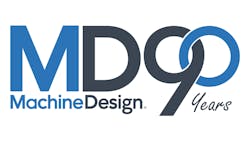As part of Machine Design’s 90th anniversary issue in January, we’ve asked industry experts to take a look at the present and future of technology and how it will impact the design and operation of manufacturing over the next decade.
Q: What products do you see that are currently solving design engineers’ problems?
Mathews: We’ve seen consumer products make giant leaps in functionality thanks to the use of modular, optimized hardware defined by software (as is the case with smartphones and even cars like Tesla). Finally, we’re starting to see it happening in manufacturing settings too.
Today, the products that are having the greatest impact for design engineers are those that combine flexible hardware with intelligent software to enable standard modular parts and thoughtful, intuitive design—similar to what you see with consumer user interface (UI).
Q: What is keeping engineers and products from getting to the root cause?
Mathews: Modular hardware defined by software is important because it democratizes who can do the work of designing and building products, and how it can scale. Currently, system integrators are a bottleneck in manufacturing, as they’re slow, expensive and unreliable. In the past, every part had to be custom designed. With modular parts and more flexible functionality, customers can now do much of this work in-house and on their own—without needing to rely on an integrator. It also means lower costs and faster deployment because modular systems are cheap and always in-stock.
Unfortunately, manufacturing is typically slow to adopt change, as processes and practices take time to become established and demonstrate real ROI and advantages for engineers. I think that’s why many new, buzzy technologies have not yet found their place on the manufacturing floor. Often, these technologies represent point solutions that don’t address the entirety of the challenges faced by manufacturers, or technologies simply don’t walk the talk (like Digital Twins that sound useful but actually lack the accuracy and ease-of-use needed to be a really useful planning tool).
Finally, however, design engineers are able to take advantage of some of the leaps in hardware and software already adopted in the consumer sphere, and as a result, design machines that are more flexible for a broader range of uses (and re-uses).
Q: What are common features and trends you are noticing in these products (variable features, flexibility, connectivity, etc.)
Mathews: Products today have much shorter life cycles; the market demands newer, better, smarter products, and ideally customized for the end-user. Smart manufacturing helps bring crucial agility and flexibility to the production process in order to better meet the quickly evolving needs of the market.
The rise of easily programmable, software-powered machines with more intuitive hardware design is driving automation adoption and also shifting the economics of product manufacturing and design. What we’re seeing is more customizable products and shorter design iteration cycles because of these more flexible machines—better machine design in the factory leads to better margins and better products, and business models that can keep up with changing market demands. For example, software enables a subscription-based business model that provides customers with a flexible service that can be scaled up or down based on need, where the software and cloud bring constant improvements and value.
Mathews: I believe that the future of machine design will continue to be led by the combination of advanced technology (like modular hardware, adaptive robotics, machine learning and computer vision) paired with the ease of code-free software UI. Of course, none of these technologies are new in and of themselves, but the way they’re applied and integrated in manufacturing settings is where real change will happen.
Past industrial robots were blind and dumb, but software, computer vision, IoT and machine learning change that equation, making them more nimble, efficient, reconfigurable and reusable. Moreover, it will enable automation of not just the production but the entire workflow of getting to production, starting with design.
By digitizing the entire manufacturing line, the data we can gather in real-time will start to bring some real value: inferred intelligence when planning processes, continuous optimization of the process, resulting in less effort, more reliable processes, higher-quality products and more efficient production lines.
Q: What will the challenges to address with incremental changes?
Mathews: First and foremost, we need to digitize every step of the manufacturing process in order to leverage the power and benefits of the advanced technologies mentioned. Imagine the iPhone as it is today, but with one difference: It is permanently attached to a cable that runs through the wall. Not so revolutionary. Once digitization is part of the equation, we can talk about holistically transforming manufacturing.
The marriage of software and hardware at scale has the potential for massive impact across industries. In manufacturing specifically, flexible and thoughtfully designed automation solutions have the potential to shift the economic possibilities for manufacturers, freeing up a workforce that had to manually tend to machines or perform repetitive tasks, increasing margins and improving the efficiency and quality of products produced.
Q: What are the challenges to groundbreaking changes?
Mathews: Based on what we’re hearing from customers, I’d say that the main driver of any new trends will be the need for flexibility and the ability to quickly adapt to changing consumer demands. Today, consumers are increasingly demanding new, fresh, smartly designed and customized products, resulting in products with much shorter lifecycles. Today’s automation solutions don’t set manufacturers up for success in this area; machines are expensive, rigid and difficult to reconfigure.
Flexibility is achieved when you introduce easily programmable software in order to become more agile. This combination of intelligent software with flexible machines allows manufacturers to quickly respond to consumer demand.
Q: What is the biggest hurdle engineers or manufacturers will face moving forward in the next decade?
Mathews: As a relatively new approach to machine design, there are many technical challenges in the integration of software with hardware to be solved. Getting machines to perform tasks with the same precision, speed and dexterity as humans is a complex journey that will span many years, if not decades.
Moreover, manufacturing as an industry has been underserved by software for over 30 years; overcoming decades of stasis is no small feat and will require a significant mindset shift in how engineers and designers approach their work. A major hurdle will be to let go of the old ways of doing things and start adopting a “software-first” approach, in general, completing the transition from analog to digitally-defined factories.
As we forecast the expansion of smart manufacturing, the industry will have to reconcile with job displacement in a constructive and impactful manner. While human job displacement is frequently buzzed about, it hasn’t become an industry-wide problem, but there is also another truth, which is that manufacturing all around the world has an issue of finding skilled labor. Exports are dying out, people joining the workforce often don’t want to go into manufacturing, and attrition rates of factory workers in some companies can go up to 1,000 people a month. We have to find solutions that can address that problem and having smart machines that are both reliable and adaptable is one way.
Q: How can people best attack these hurdles?
Mathews: With the cost of labor significantly dropping in favor of better-designed machinery, manufacturers should brainstorm productive opportunities for their dwindling workforce. I remain adamant that people who hold influence in this space, myself included, have a responsibility to build facilities in an equitable fashion. There is a growing belief in taking on accountability by upskilling workers for a more technical and savvier workforce in a way that adds new value to operations.
About the Author

Bob Vavra
Editor Emeritus, Machine Design and Power & Motion
Bob Vavra is the former senior content director of Machine Design and Power & Motion.

